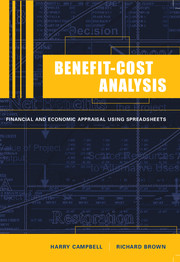Book contents
- Frontmatter
- Contents
- List of figures
- List of tables
- Preface
- Acknowledgements
- 1 Benefit-Cost Analysis: Introduction and Overview
- 2 Investment Appraisal: Principles
- 3 Investment Appraisal: Decision-Rules
- 4 Private Benefit-Cost Analysis: Financial Analysis
- 5 Efficiency Benefit-Cost Analysis
- 6 Calculating the Net Benefits to the Referent Group
- 7 Consumer and Producer Surplus in Benefit-Cost Analysis
- 8 Valuing Traded and Non-traded Commodities in Benefit-Cost Analysis
- 9 Incorporating Risk in Benefit-Cost Analysis
- 10 The Social Discount Rate, Cost of Public Funds, and the Value of Information
- 11 Weighting Net Benefits to Account for Income Distribution
- 12 Valuation of Non-marketed Goods
- 13 Economic Impact Analysis
- 14 Writing the Benefit-Cost Analysis Report
- Appendix 1 Case Study Assignment
- Appendix 2 Discount and Annuity Tables
- Index
1 - Benefit-Cost Analysis: Introduction and Overview
Published online by Cambridge University Press: 05 September 2012
- Frontmatter
- Contents
- List of figures
- List of tables
- Preface
- Acknowledgements
- 1 Benefit-Cost Analysis: Introduction and Overview
- 2 Investment Appraisal: Principles
- 3 Investment Appraisal: Decision-Rules
- 4 Private Benefit-Cost Analysis: Financial Analysis
- 5 Efficiency Benefit-Cost Analysis
- 6 Calculating the Net Benefits to the Referent Group
- 7 Consumer and Producer Surplus in Benefit-Cost Analysis
- 8 Valuing Traded and Non-traded Commodities in Benefit-Cost Analysis
- 9 Incorporating Risk in Benefit-Cost Analysis
- 10 The Social Discount Rate, Cost of Public Funds, and the Value of Information
- 11 Weighting Net Benefits to Account for Income Distribution
- 12 Valuation of Non-marketed Goods
- 13 Economic Impact Analysis
- 14 Writing the Benefit-Cost Analysis Report
- Appendix 1 Case Study Assignment
- Appendix 2 Discount and Annuity Tables
- Index
Summary
Introduction
Social benefit-cost analysis is a process of identifying, measuring and comparing the social benefits and costs of an investment project or program. A program is a series of projects undertaken over a period of time with a particular objective in view. The project or projects in question may be public projects – undertaken by the public sector – or private projects. Both types of projects need to be appraised to determine whether they represent an efficient use of resources. Projects that represent an efficient use of resources from a private viewpoint may involve costs and benefits to a wider range of individuals than their private owners. For example, a private project may pay taxes, provide employment for the otherwise unemployed, and generate pollution. These effects are termed social benefits and costs to distinguish them from the purely private costs and returns of the project. Social benefit-cost analysis is used to appraise private projects from a social viewpoint as well as to appraise public projects.
It should be noted that the technique of social benefit-cost analysis can also be used to analyse the effects of changes in public policies such as the tax/subsidy or regulatory regimes. However a very broad range of issues can arise in this kind of analysis and, for ease of exposition, we adopt the narrower perspective of project analysis in this study.
Public projects are often thought of in terms of the provision of physical capital in the form of infrastructure such as bridges, highways and dams. However there are other less obvious types of physical projects that augment environmental capital stocks and involve activities such as land reclamation, pollution control, fishery management and provision of the parks.
- Type
- Chapter
- Information
- Benefit-Cost AnalysisFinancial and Economic Appraisal using Spreadsheets, pp. 1 - 17Publisher: Cambridge University PressPrint publication year: 2003



